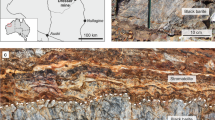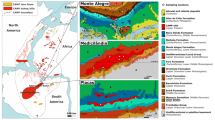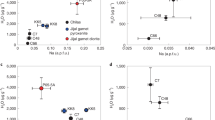Abstract
Methanogenic microbes may be one of the most primitive organisms1, although it is uncertain when methanogens first appeared on Earth. During the Archaean era (before 2.5 Gyr ago), methanogens may have been important in regulating climate, because they could have provided sufficient amounts of the greenhouse gas methane to mitigate a severely frozen condition that could have resulted from lower solar luminosity2 during these times. Nevertheless, no direct geological evidence has hitherto been available in support of the existence of methanogens in the Archaean period, although circumstantial evidence is available in the form of ∼2.8-Gyr-old carbon-isotope-depleted kerogen3. Here we report crushing extraction and carbon isotope analysis of methane-bearing fluid inclusions in ∼3.5-Gyr-old hydrothermal precipitates from Pilbara craton, Australia. Our results indicate that the extracted fluids contain microbial methane with carbon isotopic compositions of less than -56‰ included within original precipitates. This provides the oldest evidence of methanogen (> 3.46 Gyr ago), pre-dating previous geochemical evidence by about 700 million years.
This is a preview of subscription content, access via your institution
Access options
Subscribe to this journal
Receive 51 print issues and online access
$199.00 per year
only $3.90 per issue
Buy this article
- Purchase on Springer Link
- Instant access to full article PDF
Prices may be subject to local taxes which are calculated during checkout


Similar content being viewed by others
References
Woese, C. R. Bacterial evolution. Microbiol. Rev. 51, 221–271 (1987)
Kasting, J. F. & Catling, D. Evolution of a habitable planet. Annu. Rev. Astron. Astrophys. 41, 429–463 (2003)
Hayes, J. M. in Early Life on Earth (ed. Bengtson, S.) 220–236 (Columbia Univ. Press, New York, 1994)
Buick, R. & Dunlop, J. S. R. Evaporitic sediments of Early Archean age from the Warrawoona Group, North Pole, Western Australia. Sedimentology 37, 247–277 (1990)
Kitajima, K., Maruyama, S., Utsunomiya, S. & Liou, J. G. Seafloor hydrothermal alteration at Archean mid-ocean ridge. J. Metamorph. Geol. 19, 583–600 (2001)
Ueno, Y., Yoshioka, H., Maruyama, S. & Isozaki, Y. Carbon isotopes and petrography of kerogens in ∼3.5-Ga hydrothermal silica dikes in the North Pole area, Western Australia. Geochim. Cosmochim. Acta 68, 573–589 (2004)
Shen, Y., Buick, R. & Canfield, D. E. Isotopic evidence for microbial sulphate reduction in the early Archaean era. Nature 410, 77–81 (2001)
Awramik, S. M., Schopf, J. W. & Walter, M. R. Filamentous fossil bacteria from the Archean of Western Australia. Precambr. Res. 20, 357–374 (1983)
Ueno, Y., Isozaki, Y., Yurimoto, H. & Maruyama, S. Carbon isotopic signatures of individual Archean microfossils (?) from Western Australia. Int. Geol. Rev. 43, 196–212 (2001)
Buick, R. Microfossil recognition in Archean rocks: an appraisal of spheroids and filaments from a 3500 M.Y. old chert-barite unit at North Pole, Western Australia. Palaios 5, 441–491 (1990)
Garcia Ruiz, J. M. et al. Self-assembled silica-carbonate structures and detection of ancient microfossils. Science 302, 1194–1197 (2003)
Thorpe, R. I., Hickman, A. H., Davis, D. W., Mortensen, J. K. & Trendall, A. F. in The Archaean: Terrains, Processes and Metallogeny (eds Glover, J. E. & Ho, S. E.) 395–406 (Univ. Western Australia Publ. 9, Perth, 1992)
Nijman, W., de Bruijne, K. H. & Valkering, M. E. Growth fault control of Early Archaean cherts, barite mounds and chert-barite veins, North Pole Dome, Eastern Pilbara, Western Australia. Precambr. Res. 95, 247–274 (1999)
Van Kranendonk, M. J. & Pirajno, F. Geochemistry of metabasalts and hydrothermal alteration zones associated with c. 3.45 Ga chert and barite deposits: implications for the geological setting of the Warrawoona Group, Pilbara Craton, Australia. Geochem. Explor. Envir. Anal. 4, 253–278 (2004)
Brasier, M. D. et al. Questioning the evidence for Earth's oldest fossils. Nature 416, 76–81 (2002)
Pinti, D. L., Hashizume, K. & Matsuda, J. Nitrogen and argon signatures in 3.8 to 2.8 Ga metasediments: clues on the chemical state of the Archean ocean and the deep biosphere. Geochim. Cosmochim. Acta 65, 2301–2315 (2001)
Roedder, E. Fluid Inclusions (Reviews in Mineralogy vol. 12, Mineralogical Society of America, Washington DC, 1984).
Schoell, M. Genetic characterization of natural gas. Am. Assoc. Petrol. Geol. Bull. 67, 2225–2238 (1983)
Whiticar, M. J. Carbon and hydrogen isotope systematics of bacterial formation and oxidation of methane. Chem. Geol. 161, 291–314 (1999)
Valentine, D. L., Chidthaisong, A., Rice, A., Reeburgh, W. S. & Tyler, S. C. Carbon and hydrogen isotope fractionation by moderately thermophilic methanogens. Geochim. Cosmochim. Acta 68, 1571–1590 (2004)
Clayton, C. Carbon isotope fractionation during natural gas generation from kerogen. Mar. Petrol. Geol. 8, 232–240 (1991)
Horita, J. & Berndt, M. E. Abiogenic methane formation and isotopic fractionation under hydrothermal conditions. Science 285, 1055–1057 (1999)
McCollom, T. M. & Seewald, J. S. A reassessment of the potential for reduction of dissolved CO2 to hydrocarbons during serpentinization of olivine. Geochim. Cosmochim. Acta 65, 3769–3778 (2001)
Sherwood Lollar, B., Westgate, T. D., Ward, J. A., Slater, G. F. & Lacrampe-Couloume, G. Abiogenic formation of alkanes in the Earth's crust as a minor source for global hydrocarbon reservoirs. Nature 416, 522–524 (2002)
Welhan, J. A. Origin of methane in hydrothermal systems. Chem. Geol. 71, 183–198 (1988)
Charlou, J. L., Donval, J. P., Fouquet, Y., Jean-Baptiste, P. & Holm, N. G. Geochemistry of high H2 and CH4 vent fluids issuing from ultramafic rocks at the Rainbow hydrothermal field (36°14′N, MAR). Chem. Geol. 191, 345–359 (2002)
Richet, P., Bottinga, Y. & Javoy, M. A review of hydrogen, carbon, nitrogen, oxygen, sulphur, and chlorine stable isotope fractionation among gaseous molecules. Annu. Rev. Earth Planet. Sci. 5, 65–110 (1977)
Acknowledgements
We thank M. Terabayashi, Y. Kato, K. Okamoto, T. Ota, T. Kabashima, K. Kitajima and K. Shimizu for assistance in field work, A. Thorne, K. J. McNamara and A. H. Hickman for field collaboration, H. Nara, Y. Matsui and M. Nishizawa for assisting in the construction of the vacuum line, and R. Buick and J. F. Kasting for comments on early versions of this manuscript. This research was supported by the 21st Century COE Program ‘How to build habitable planets,’ Tokyo Institute of Technology, sponsored by the Ministry of Education, Culture, Sports, Technology and Science, Japan. Y.U. thanks the Research Fellowships of the Japan Society for the Promotion of Science for Young Scientists.
Author information
Authors and Affiliations
Corresponding author
Ethics declarations
Competing interests
Reprints and permissions information is available at npg.nature.com/reprintsandpermissions. The authors declare no competing financial interests.
Supplementary information
Supplementary Figures
This file contains Supplementary Figures 1, 2 and 3 with legends, which show sample locality map, more detailed photomicrographs of the fluid inclusions, and Universal Tree of Life with age constraints, respectively. (DOC 1105 kb)
Supplementary Notes
This file contains Supplementary Methods, Supplementary Figures 3 and 4 with legends, and Supplementary Tables 1 and 2, which describe methods and results of the laser Raman and carbon isotope analyses. Supplementary Data includes the list of modern hydrothermal vent sites compiled in Fig. 2c of the main text with data source used for the compilation. (PDF 370 kb)
Rights and permissions
About this article
Cite this article
Ueno, Y., Yamada, K., Yoshida, N. et al. Evidence from fluid inclusions for microbial methanogenesis in the early Archaean era. Nature 440, 516–519 (2006). https://doi.org/10.1038/nature04584
Received:
Accepted:
Issue Date:
DOI: https://doi.org/10.1038/nature04584
This article is cited by
-
Modern analogs for ammonia flux from terrestrial hydrothermal features to the Archean atmosphere
Scientific Reports (2024)
-
Structures of the sulfite detoxifying F420-dependent enzyme from Methanococcales
Nature Chemical Biology (2023)
-
Liquid and supercritical CO2 as an organic solvent in Hadean seafloor hydrothermal systems: implications for prebiotic chemical evolution
Progress in Earth and Planetary Science (2022)
-
2470 million-year-old banded iron formation reveals a climatic oscillation consistent with the Gleissberg solar cycle
Communications Earth & Environment (2022)
-
Expression of divergent methyl/alkyl coenzyme M reductases from uncultured archaea
Communications Biology (2022)
Comments
By submitting a comment you agree to abide by our Terms and Community Guidelines. If you find something abusive or that does not comply with our terms or guidelines please flag it as inappropriate.



